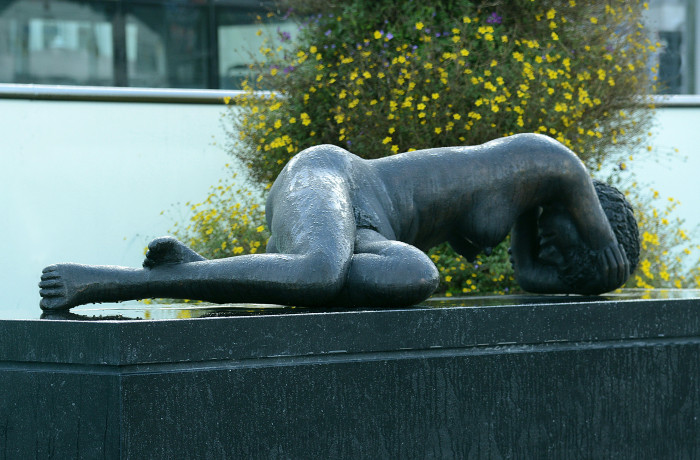LA TORDUE (GEORGE GRARD)
A second statue facing the Tourist Office, close to first one, is also by Georges Grard. Larger and more fragile in her nakedness, ‘La Tordue’ draws all attention to herself.
‘La Tordue’ refers to one of his earlier works ‘The Sea’ or ‘Lying Nude’ in Ostend. This last statue (1952-1955) is nicknamed ‘Fat Mathilda’ by the locals and symbolizes the lushness and sensuality of the sea in a woman's body.
Over the years ‘Fat Mathilda’ was regularly waylaid by groups with moralistic or political missions. Since 2005 it has been on the list of protected statues of Ostend.
The cultural attaches in Ostend would have preferred their statue to be closer to the seafront, likewise ’Kunst in de stad’ would have preferred a location on a water surface for ‘La Tordue’, since the statue is nicer when reflected in water. Now it is installed on natural stone and is at it nicest after rainfall.
‘La Tordue’ invites to be touched. However, spectators apparently will sooner be tempted to touch abstract than figurative works of art.
GRARD George (1901- 1984)
Georges Grard, born in 1901, studied sketching, sculpture and painting at the Academy of Fine Arts in Tournai. He is generally acknowledged to be one of the greatest figurative Belgian sculptors. In 1930 he won the Rubens Prize of the Museum of fine Arts in Brussels. In 1935, Grard founds the ‘School of Sint-Idesbald’ with some artist friends among whom Paul Delvaux,. In 1935 the sculptor wins the ‘Prize of Hainaut’ and the ‘Prize Picard of the Free Academy of Belgium’. In 1967 he becomes a member of the Class of Fine Arts, section Sculpture, of the Belgian Royal Academy for Science, Literature and Fine Arts, where he wins the quinquennial prize, a culmination of his artistic career. The George Grard Museum in Sint-Idesbald houses the plaster moulds and on the territory of Ten Bogaerde, the bronze sculptures.
Kunst in de Stad – October 19th 2013

